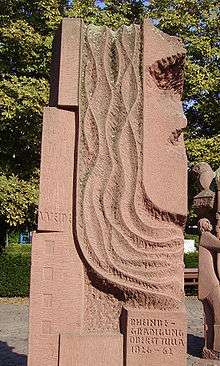Johann Gottfried Tulla

Johann Gottfried Tulla (born 20 March 1770 in Karlsruhe; died 27 March 1828 in Paris) was a German engineer who accomplished the straightening of the Rhine, improving navigation and alleviating the effects of flooding. His measures gave the Upper Rhine a completely new appearance. The river was deepened and channelled between embankments, new sections were dug to straighten out its meandering course, and numerous small islands were removed. The effect was to reduce the river's length between Basel and Worms from 355 km to 275 km (220 to 170 miles).[1] However, the straightening of the Upper Rhine may have increased the flood risk in the region of the Middle and Lower Rhine,[2] partial floodplain restoration is performed in a joint program of Germany and France.
Career
Tulla began his training in 1792 with Karl Christian von Langsdorf. In 1795 he began to study chemistry and mineralogy at the Mining Academy in Freiberg, Saxony. Subsequently he was transferred to government service in Baden. Further training in Paris followed in 1801, but he was called back to Karlsruhe after a year. There he was appointed to the rank of captain in 1803. Starting in 1807 he worked in Switzerland on the channelling of the Linth river. Also in 1807 he was one of the founders of the school of engineering that was the predecessor of the University of Karlsruhe. He was promoted several times in subsequent years, in 1809 to major and in 1814 to lieutenant colonel. In 1817 he was appointed director of the Oberdirektion des Wasser- und Straßenbaues (Directorate of Water and Road Construction). In this office he was instrumental in planning the stabilizing and straightening of the course of the Upper Rhine, a huge river engineering project that continued until 1879, long after his death. His appointment as an officer of the French Légion d'honneur followed in 1827.
Tulla died of the consequences of malaria in 1828 and was buried in the Montmartre Cemetery in Paris. His gravestone shows the "Altrip corner," one of the technically most difficult sections of the Rhine straightening, near the village of Altrip in the Palatinate.
References
- ↑ Crump, Thomas (2007). A Brief History of the Age of Steam: The Power that Drove the Industrial Revolution. Carroll & Graf Publishers. ISBN 9780786720477. Retrieved 2015-04-08.
- ↑ Blackbourn, David (2011-11-30). The Conquest Of Nature: Water, Landscape, and the Making of Modern Germany. Random House. ISBN 9781448114214. Retrieved 2015-04-08.